warning light Seat Ibiza ST 2009 Service Manual
[x] Cancel search | Manufacturer: SEAT, Model Year: 2009, Model line: Ibiza ST, Model: Seat Ibiza ST 2009Pages: 250, PDF Size: 6.4 MB
Page 117 of 250
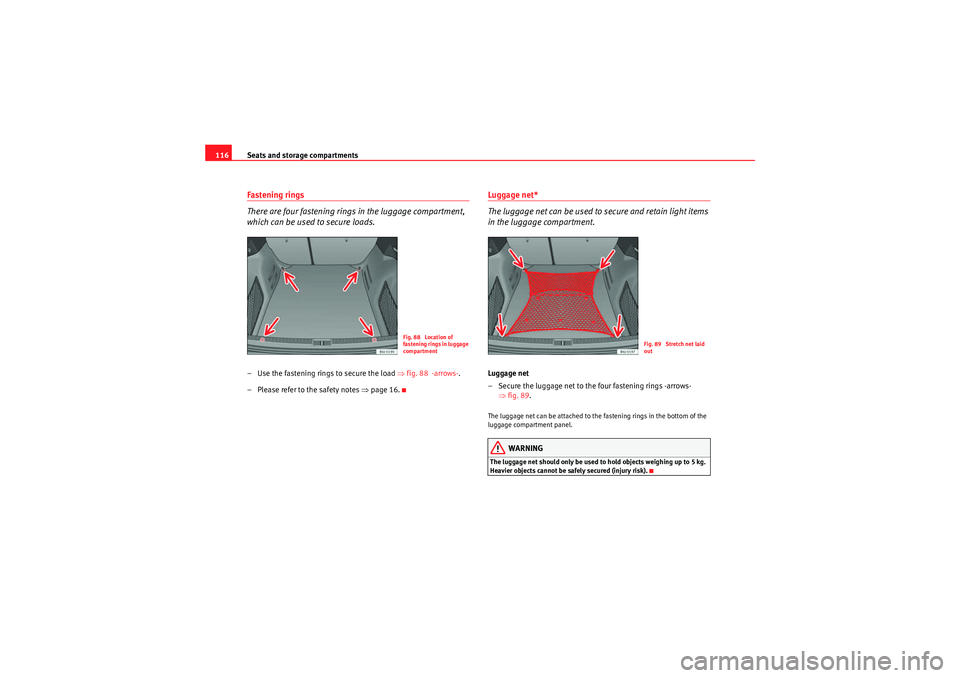
Seats and storage compartments
116Fastening rings
There are four fastening rings in the luggage compartment,
which can be used to secure loads.– Use the fastening ring s to secure the load ⇒fig. 88 -arrows-.
– Please refer to the safety notes ⇒page 16.
Luggage net*
The luggage net can be used to secure and retain light items
in the luggage compartment.Luggage net
– Secure the luggage net to the four fastening rings -arrows-
⇒fig. 89 .The luggage net can be attached to the fastening rings in the bottom of the
luggage compartment panel.
WARNING
The luggage net should only be used to hold objects weighing up to 5 kg.
Heavier objects cannot be safely secured (injury risk).
Fig. 88 Location of
fastening rings in luggage
compartment
Fig. 89 Stretch net laid
out
Ibiza ST_EN.book Seite 116 Dienstag, 12. Januar 2010 4:03 16
Page 119 of 250

Seats and storage compartments
118Rear shelf with storage compartment*
To remove the storage compartment
– Remove the rear shelf and pull the storage compartment
upwards holding it by the edges ⇒fig. 91 .The storage compartment can be accessed from the rear seats by lifting the
front side of the rear shelf ⇒fig. 92 .
WARNING
Do not place heavy or hard objects on the rear shelf, because they will
endanger the vehicle occupants in case of sudden braking.
Caution
•Before closing the rear lid, ensure that the rear shelf is correctly fitted.•An overloaded luggage compartment could mean that the rear shelf is not
correctly seated and it may be bent or damaged.•If the luggage compartment is overloaded, remove the tray.•The load in the storage compartment should not exceed 3 kg.Note
•Ensure that, when placing items of clothing on the luggage compartment
cover, rear visibility is not reduced.•If your vehicle has a storage compartment*, only place light objects
inside.Roof carrier*Please observe the following points if you intend to carry loads on the roof:
Fig. 91 Removing
storage compartmentFig. 92 Accessing
storage compartment
Ibiza ST_EN.book Seite 118 Dienstag, 12. Januar 2010 4:03 16
Page 121 of 250
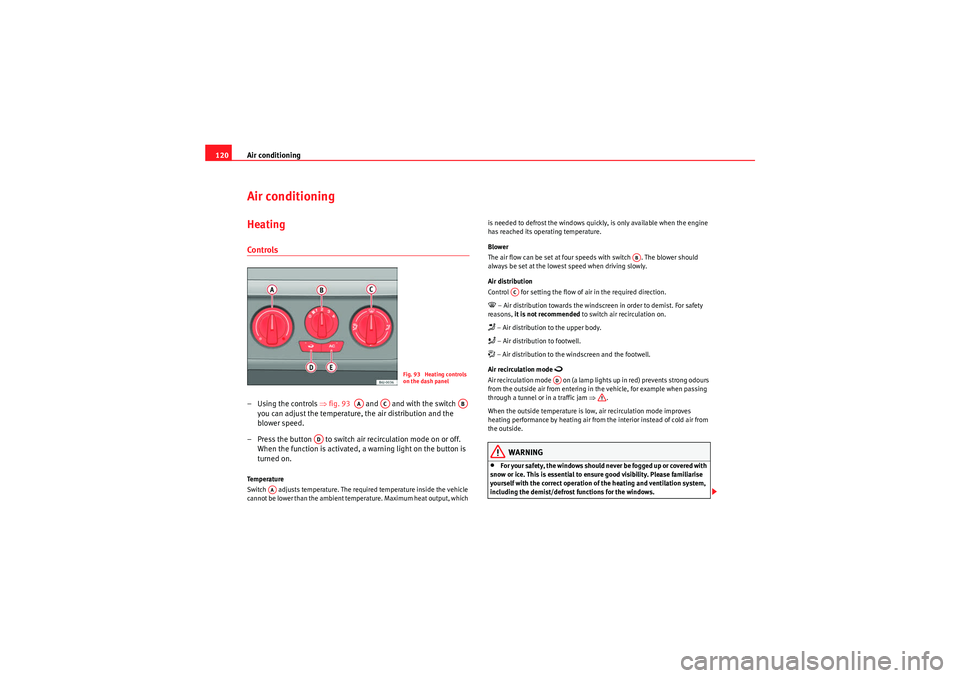
Air conditioning
120Air conditioningHeatingControls– Using the controls ⇒fig. 93 and and with the switch
you can adjust the temperature, the air distribution and the
blower speed.
– Press the button to switch air recirculation mode on or off. When the function is activated, a warning light on the button is
turned on.Te m p e r a t u r e
Switch adjusts temperature. The required temperature inside the vehicle
cannot be lower than the ambient temperature. Maximum heat output, which is needed to defrost the windows quickly, is only available when the engine
has reached its operating temperature.
Blower
The air flow can be set at four speeds with switch . The blower should
always be set at the lowest speed when driving slowly.
Air distribution
Control for setting the flow of air in the required direction.
– Air distribution towards the windscreen in order to demist. For safety
reasons, it is not recommended to switch air recirculation on. – Air distribution to the upper body. – Air distribution to footwell. – Air distribution to the windscreen and the footwell.
Air recirculation mode
Air recirculation mode on (a lam p lights up in red) prevents strong odours
from the outside air from entering in the vehicle, for example when passing
through a tunnel or in a traffic jam ⇒.
When the outside temperature is low, air recirculation mode improves
heating performance by heating air from the interior instead of cold air from
the outside.
WARNING
•For your safety, the windows should never be fogged up or covered with
snow or ice. This is essential to ensure good visibility. Please familiarise
yourself with the correct operation of the heating and ventilation system,
including the demist/defrost functions for the windows.
Fig. 93 Heating controls
on the dash panel
AA
AC
AB
AD
AA
AB
AC
AD
Ibiza ST_EN.book Seite 120 Dienstag, 12. Januar 2010 4:03 16
Page 124 of 250

Air conditioning123
Safety First
Operating instructions
Practical tips
Technical Data
Air distribution
Outlets and can be closed or opened separately and the air flow
directed as required.
Air conditioning* ControlsThe air conditioning system only works when the engine is running
and the fan is switched on.
–Using the controls
⇒fig. 96 and and with the switch
you can adjust the temperature, the air distribution and the
blower speed.
– To switch a function on or off, press the appropriate button or . When the function is activated, a red warning light on the
button is turned on.
– To demist the wind screens:
– Turn air distribution to
Switch on symbol
Main air output through outlets:
1,2
5
1, 2, 5
3, 4
AC
A3
A4
Fig. 96 Air conditioning
controls on the dash
panel
AA
AC
ABAD
AE
Ibiza ST_EN.book Seite 123 Dienstag, 12. Januar 2010 4:03 16
Page 125 of 250
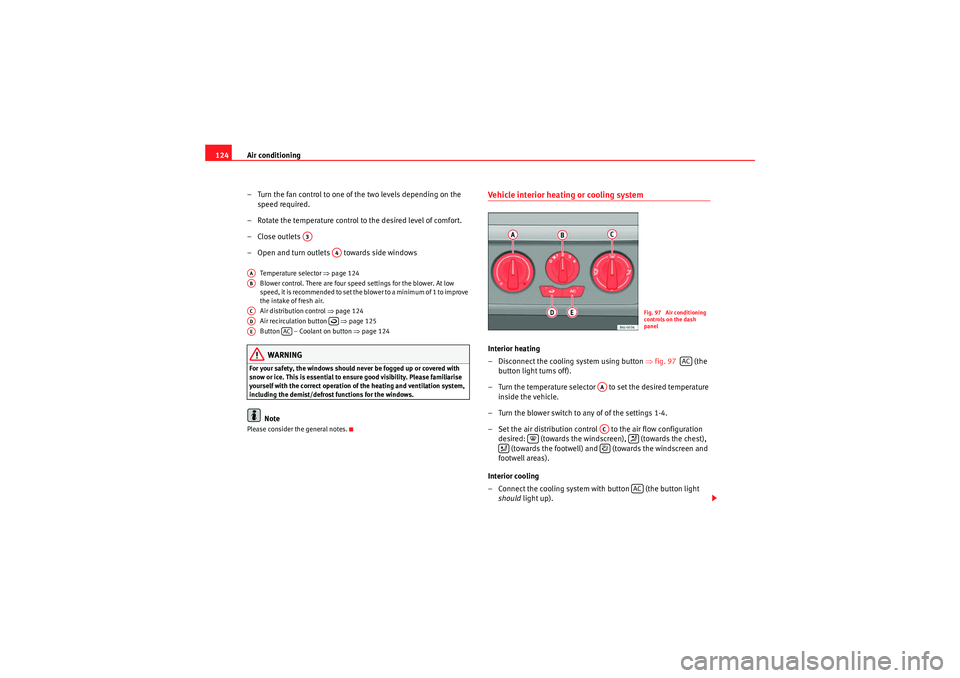
Air conditioning
124
– Turn the fan control to one of the two levels depending on the speed required.
– Rotate the temperature control to the desired level of comfort.
–Close outlets
– Open and turn outlets towards side windows
Temperature selector ⇒page 124
Blower control. There are four speed settings for the blower. At low
speed, it is recommended to set the blower to a minimum of 1 to improve
the intake of fresh air.
Air distribution control ⇒page 124
Air recirculation button ⇒page 125
Button – Coolant on button ⇒page 124WARNING
For your safety, the windows should never be fogged up or covered with
snow or ice. This is essential to ensure good visibility. Please familiarise
yourself with the correct operation of the heating and ventilation system,
including the demist/defrost functions for the windows.
Note
Please consider the general notes.
Vehicle interior heating or cooling system Interior heating
– Disconnect the cooling system using button ⇒fig. 97 (the
button light turns off).
– Turn the temperature selector to set the desired temperature inside the vehicle.
– Turn the blower switch to any of of the settings 1-4.
– Set the air distribution control to the air flow configuration desired: (towards the windscreen), (towards the chest), (towards the footwell) and (towards the windscreen and
footwell areas).
Interior cooling
– Connect the cooling system with button (the button light should light up).
A3
A4
AAABACAD
AE
AC
Fig. 97 Air conditioning
controls on the dash
panel
AC
AAAC
AC
Ibiza ST_EN.book Seite 124 Dienstag, 12. Januar 2010 4:03 16
Page 126 of 250
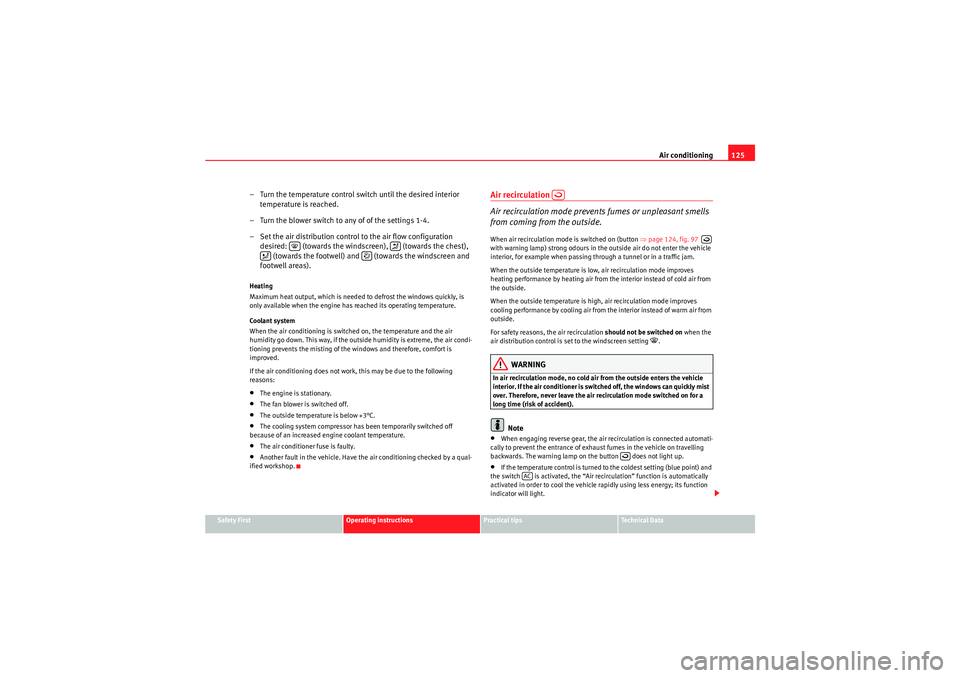
Air conditioning125
Safety First
Operating instructions
Practical tips
Technical Data
– Turn the temperature control switch until the desired interior
temperature is reached.
– Turn the blower switch to any of of the settings 1-4.
– Set the air distribution contro l to the air flow configuration
desired: (towards the windscreen), (towards the chest),
(towards the footwell) and (towards the windscreen and
footwell areas).Heating
Maximum heat output, which is needed to defrost the windows quickly, is
only available when the engine has reached its operating temperature.
Coolant system
When the air conditioning is switched on, the temperature and the air
humidity go down. This way, if the outside humidity is extreme, the air condi-
tioning prevents the misting of the windows and therefore, comfort is
improved.
If the air conditioning does not work, this may be due to the following
reasons:•The engine is stationary.•The fan blower is switched off.•The outside temperature is below +3°C.•The cooling system compressor has been temporarily switched off
because of an increased engine coolant temperature.•The air conditioner fuse is faulty.•Another fault in the vehicle. Have the air conditioning checked by a qual-
ified workshop.
Air recirculation
Air recirculation mode prevents fumes or unpleasant smells
from coming from the outside.When air recirculation mode is switched on (button ⇒ page 124, fig. 97
with warning lamp) strong odours in the outside air do not enter the vehicle
interior, for example when passing through a tunnel or in a traffic jam.
When the outside temperature is low, air recirculation mode improves
heating performance by heating air from the interior instead of cold air from
the outside.
When the outside temperature is high, air recirculation mode improves
cooling performance by cooling air from the interior instead of warm air from
outside.
For safety reasons, the air recirculation should not be switched on when the
air distribution control is set to the windscreen setting
.
WARNING
In air recirculation mode, no cold air from the outside enters the vehicle
interior. If the air conditioner is switched off, the windows can quickly mist
over. Therefore, never leave the air recirculation mode switched on for a
long time (risk of accident).
Note
•When engaging reverse gear, the air recirculation is connected automati-
cally to prevent the entrance of exhaust fumes in the vehicle on travelling
backwards. The warning lamp on the button does not light up.•If the temperature control is turned to the coldest setting (blue point) and
the switch is activated, the “Air recirculation” function is automatically
activated in order to cool the vehicle rapidly using less energy; its function
indicator will light.
AC
Ibiza ST_EN.book Seite 125 Dienstag, 12. Januar 2010 4:03 16
Page 128 of 250
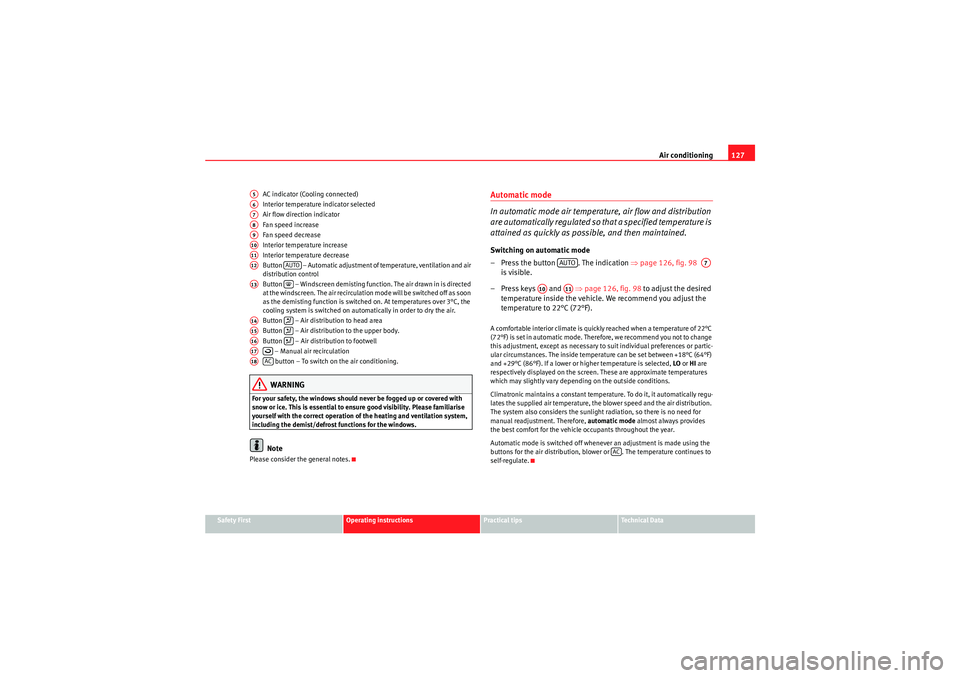
Air conditioning127
Safety First
Operating instructions
Practical tips
Technical Data
AC indicator (Cooling connected)
Interior temperature indicator selected
Air flow direction indicator
Fan speed increase
Fan speed decrease
Interior temperature increase
Interior temperature decrease
Button – Automatic adjustment of temperature, ventilation and air
distribution control
Button – Windscreen demisting function. The air drawn in is directed
at the windscreen. The air recirculation mode will be switched off as soon
as the demisting function is switched on. At temperatures over 3°C, the
cooling system is switched on automatically in order to dry the air.
Button – Air distribution to head area
Button – Air distribution to the upper body.
Button – Air distribution to footwell
– Manual air recirculation
button – To switch on the air conditioning.
WARNING
For your safety, the windows should never be fogged up or covered with
snow or ice. This is essential to ensure good visibility. Please familiarise
yourself with the correct operation of the heating and ventilation system,
including the demist/defrost functions for the windows.
Note
Please consider the general notes.
Automatic mode
In automatic mode air temperature, air flow and distribution
are automatically regulated so that a specified temperature is
attained as quickly as possible, and then maintained.Switching on automatic mode
– Press the button . The indication ⇒page 126, fig. 98
is visible.
–Press keys and ⇒page 126, fig. 98 to adjust the desired
temperature inside the vehicle. We recommend you adjust the
temperature to 22°C (72°F).A comfortable interior climate is quickly reached when a temperature of 22°C
(72°F) is set in automatic mode. Therefore, we recommend you not to change
this adjustment, except as necessary to suit individual preferences or partic-
ular circumstances. The inside temperature can be set between +18°C (64°F)
and +29°C (86°F). If a lower or higher temperature is selected, LO or HI are
respectively displayed on the screen. These are approximate temperatures
which may slightly vary depending on the outside conditions.
Climatronic maintains a constant temperature. To do it, it automatically regu-
lates the supplied air temperature, the blower speed and the air distribution.
The system also considers the sunlight radiation, so there is no need for
manual readjustment. Therefore, automatic mode almost always provides
the best comfort for the vehicle occupants throughout the year.
Automatic mode is switched off whenever an adjustment is made using the
buttons for the air distribution, blower or . The temperature continues to
self-regulate.
A5A6A7A8A9A10A11A12
AUTO
A13
A14
A15
A16
A17
A18
AC
AUTO
A7
A10
A11
AC
Ibiza ST_EN.book Seite 127 Dienstag, 12. Januar 2010 4:03 16
Page 132 of 250
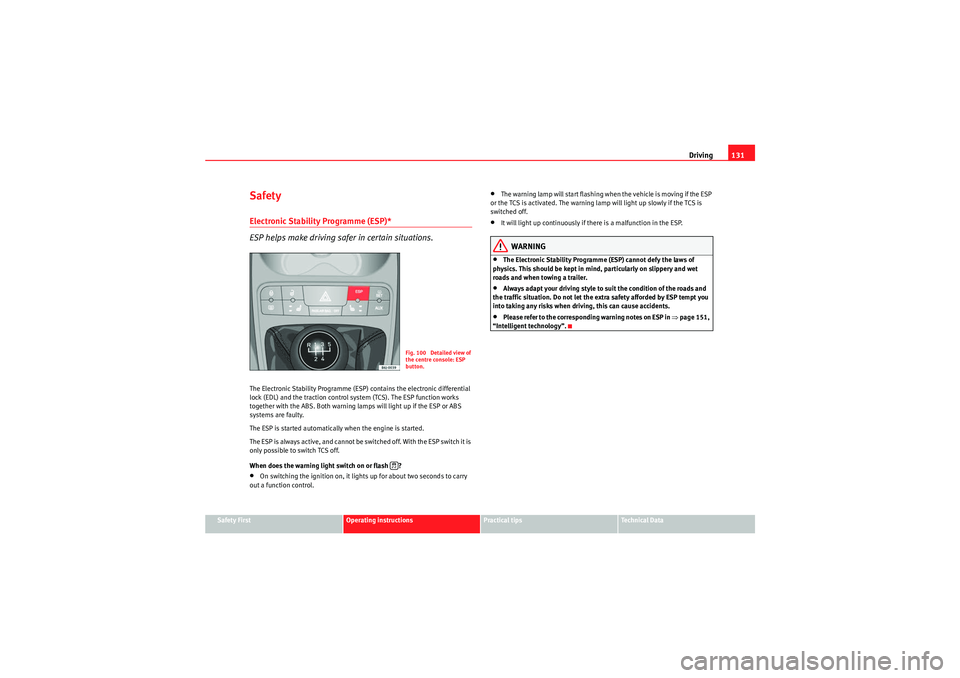
Driving131
Safety First
Operating instructions
Practical tips
Technical Data
SafetyElectronic Stabilit y Programme (ESP)*
ESP helps make driving safer in certain situations.The Electronic Stability Programme (ESP) contains the electronic differential
lock (EDL) and the traction control system (TCS). The ESP function works
together with the ABS. Both warning lamps will light up if the ESP or ABS
systems are faulty.
The ESP is started automatically when the engine is started.
The ESP is always active, and cannot be switched off. With the ESP switch it is
only possible to switch TCS off.
When does the warning light switch on or flash ?•On switching the ignition on, it lights up for about two seconds to carry
out a function control.
•The warning lamp will start flashing when the vehicle is moving if the ESP
or the TCS is activated. The warning lamp will light up slowly if the TCS is
switched off.•It will light up continuously if there is a malfunction in the ESP.WARNING
•The Electronic Stability Programme (ESP) cannot defy the laws of
physics. This should be kept in mind, particularly on slippery and wet
roads and when towing a trailer.•Always adapt your driving style to suit the condition of the roads and
the traffic situation. Do not let the extra safety afforded by ESP tempt you
into taking any risks when driving, this can cause accidents.•Please refer to the corresponding warning notes on ESP in ⇒page 151,
“Intelligent technology”.
Fig. 100 Detailed view of
the centre console: ESP
button.
Ibiza ST_EN.book Seite 131 Dienstag, 12. Januar 2010 4:03 16
Page 134 of 250
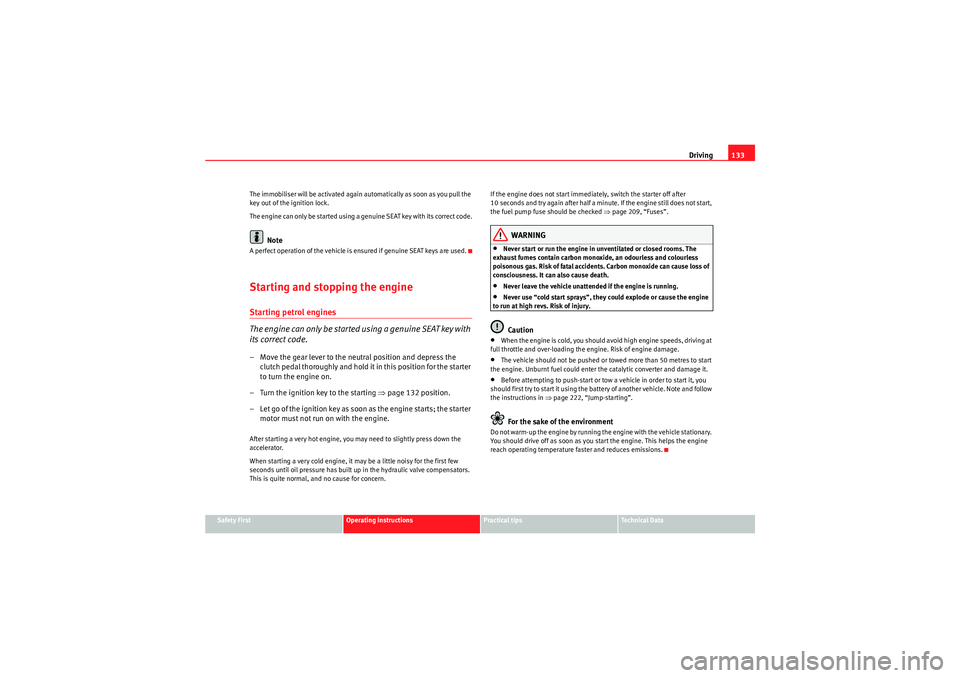
Driving133
Safety First
Operating instructions
Practical tips
Technical Data
The immobiliser will be activated again automatically as soon as you pull the
key out of the ignition lock.
The engine can only be started using a genuine SEAT key with its correct code.
Note
A perfect operation of the vehicle is ensured if genuine SEAT keys are used.Starting and stopping the engineStarting petrol engines
The engine can only be started using a genuine SEAT key with
its correct code.– Move the gear lever to the neutral position and depress the
clutch pedal thoroughly and hold it in this position for the starter
to turn the engine on.
– Turn the ignition key to the starting ⇒page 132 position.
– Le t go o f the ig nit io n key as so on as the e ngin e star t s; t he sta r ter motor must not run on with the engine.After starting a very hot engine, you may need to slightly press down the
accelerator.
When starting a very cold engine, it may be a little noisy for the first few
seconds until oil pressure has built up in the hydraulic valve compensators.
This is quite normal, and no cause for concern. If the engine does not start immediately, switch the starter off after
10 seconds and try again after half a minute. If the engine still does not start,
the fuel pump fuse should be checked
⇒page 209, “Fuses”.
WARNING
•Never start or run the engine in unventilated or closed rooms. The
exhaust fumes contain carbon monoxide, an odourless and colourless
poisonous gas. Risk of fatal accidents. Carbon monoxide can cause loss of
consciousness. It can also cause death.•Never leave the vehicle unattended if the engine is running.•Never use “cold start sprays”, they could explode or cause the engine
to run at high revs. Risk of injury.Caution
•When the engine is cold, you should avoid high engine speeds, driving at
full throttle and over-loading the engine. Risk of engine damage.•The vehicle should not be pushed or towed more than 50 metres to start
the engine. Unburnt fuel could enter the catalytic converter and damage it.•Before attempting to push-start or tow a vehicle in order to start it, you
should first try to start it using the battery of another vehicle. Note and follow
the instructions in ⇒page 222, “Jump-starting”.For the sake of the environment
Do not warm-up the engine by running the engine with the vehicle stationary.
You should drive off as soon as you start the engine. This helps the engine
reach operating temperature faster and reduces emissions.
Ibiza ST_EN.book Seite 133 Dienstag, 12. Januar 2010 4:03 16
Page 135 of 250

Driving
134Starting diesel engines
The engine can only be started using a genuine SEAT key with
its correct code.– Move the gear lever to the neutral position and depress the
clutch pedal thoroughly and hold it in this position for the starter
to turn the engine on.
– Turn the ignition key to the starting position.
– Turn the ignition key to position ⇒page 132, fig. 101 . The
indicator lamp
will light for engine pre-heating.
– When the warning lamp turns off, turn the key to position to start the engine. Do not press the accelerator.
– Let go of the ignition key as soon as the engine starts, the starter motor must not be allowed to run on with the engine.
When starting a very cold engine, it may be a little noisy for the first few
seconds until oil pressure has built up in the hydraulic valve compensators.
This is quite normal, and no cause for concern.
If there are problems starting the engine, see the ⇒page 222.
Glow plug system for the diesel engine
To avoid unnecessary discharging of the battery, do not use any other major
electrical equipment while the glow plugs are pre-heating.
Start the engine as soon as the glow plug warning lamp goes out.
Starting the engine after the fuel tank has been completely run dry
If the fuel tank has been completely run dry, it may take longer than normal
(up to one minute) to start the engine after refuelling with diesel fuel. This is
because the system must eliminate air first.
WARNING
•Never start or run the engine in un ventilated or closed rooms. The
exhaust fumes contain carbon monoxide, an odourless and colourless
poisonous gas. Risk of fatal accidents. Carbon monoxide can cause loss of
consciousness. It can also cause death.•Never leave the vehicle unattended if the engine is running.•Never use “cold start sprays”, they could explode or cause the engine
to run at high revs. Risk of injury.Caution
•When the engine is cold, you should avoid high engine speeds, driving at
full throttle and over-loading the engine. Risk of engine damage.•The vehicle should not be pushed or towed more than 50 metres to start
the engine. Unburnt fuel could enter the catalytic converter and damage it.•Before attempting to push-start or tow a vehicle in order to start it, you
should first try to start it using the battery of another vehicle. Note and follow
the instructions in ⇒ page 222, “Jump-starting”.For the sake of the environment
Do not warm-up the engine by running the engine with the vehicle stationary.
You should drive off as soon as you start the engine. This helps the engine
reach operating temperature faster and reduces emissions.Switching the engine off– Stop the vehicle.
– Turn the ignition key to position ⇒page 132, fig. 101 .
A2A3
A1
Ibiza ST_EN.book Seite 134 Dienstag, 12. Januar 2010 4:03 16